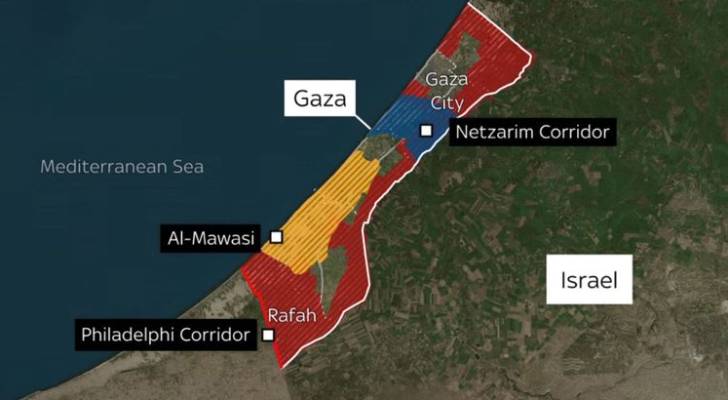Ceasefire talks stuck over ‘Israel’s’ demand to hold Morag Corridor in Gaza
Hebrew media reports have revealed the main remaining dispute between the Israeli Occupation and Hamas as negotiations continue to reach a ceasefire agreement to end the war in Gaza.
According to US officials, the number of outstanding issues has dropped from four to one.
US Middle East envoy Steve Wietkov expressed optimism about a possible agreement by the end of the week, saying the gaps between the two sides have become “clearer and fewer.”
According to Yedioth Ahronoth (Ynet), the primary point of contention is the 'Israeli' plan to maintain control over a narrow strip of land in southern Gaza known as the "Morag Corridor." This corridor runs south of Khan Younis along the Egyptian border and serves as a strategic military route.
'Israeli' Prime Minister Benjamin Netanyahu has referred to the area as “Philadelphi 2,” a reference to the original Philadelphi Corridor, a buffer zone along the Gaza-Egypt border. The plan calls for the 'Israeli' military to remain in the Morag Corridor even after a ceasefire is reached, something Hamas firmly opposes. Netanyahu argues that continued control is necessary to prevent Hamas from rearming through cross-border tunnels.
The proposal has sparked internal debate within the 'Israeli' military establishment. Some officials have warned that holding onto the corridor could hinder progress toward a deal to release captives, questioning the strategic necessity of the strip.
Strategic importance of Morag Axis for 'Israel'
The Morag Axis holds critical operational and military significance for the Israeli Occupation, serving several key objectives:
- Isolation and Separation: The primary goal is to cut geographic and operational links between Khan Younis and Rafah, creating a continuous siege on Rafah and isolating it alongside Khan Younis, both above and below ground. This corridor is referred to as the "Second Philadelphia," drawing a comparison to the border axis with Egypt, aimed at limiting the movements of resistance forces.
- Operational Buffer Zone: The Israeli army views control of the axis as establishing a "buffer zone" that enables rapid response, identification of resistance infrastructure, and sustained military pressure, even amid ceasefire agreements.
Freedom of Military Action: From the political leadership’s perspective, maintaining control over the axis secures a "foot in the door," ensuring ongoing freedom for military operations inside Gaza and preventing relinquishment of strategic routes. - Operational Flexibility: The axis provides significant flexibility for troop deployment and prevents Hamas fighters from returning to Rafah. It acts as an internal boundary dividing parts of Gaza that Israel seeks to control while facilitating the deployment of international monitoring mechanisms.
Positions of the Parties in Negotiations
- Israeli Occupation: 'Israel' insists during current negotiations in Doha on not withdrawing from the Morag Axis and refuses to relinquish control of US aid distribution centers, although it has shown some flexibility regarding United Nations involvement in aid distribution.
- Hamas: The movement views 'Israel’s' demand as a severe political setback, effectively preventing it from regaining full control over southern Gaza. Accordingly, Hamas categorically rejects any 'Israeli' presence in the Morag Axis, which could jeopardize chances for an agreement.
At the White House, US President Donald Trump met with Netanyahu late Tuesday for the second time in under 24 hours, as American and Qatari mediators continue pushing for a ceasefire to end the war that began in October 2023.
“This crisis must be resolved. Gaza is a tragedy. He wants it resolved, I want it resolved, and I believe the other side wants that too,” Trump said in remarks quoted by Yedioth Ahronoth. The paper also reported that Trump applied “maximum pressure” on Netanyahu to move forward with a ceasefire deal.
Following the meeting, Netanyahu said: “We focused all efforts on securing the release of our hostages. We will not stop for a moment. This is only possible due to the military pressure exerted by our brave soldiers. Sadly, this effort comes at a painful cost—the loss of our finest.”




